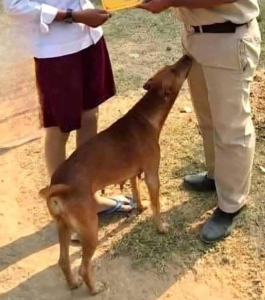Why Dogs Sniff Private Areas — The Science Behind the Behavior
If you’ve ever been around dogs, you’ve probably experienced that slightly awkward moment when a friendly pup greets you not by wagging its tail or licking your hand, but by sticking its nose somewhere… well, personal. While it may be uncomfortable for humans, this behavior is completely natural and deeply rooted in the biology and communication system of dogs. Understanding why dogs do this can transform embarrassment into appreciation for just how incredible their sense of smell really is.
The Nose Knows Everything
To grasp this behavior, we need to start with one astonishing fact: a dog’s sense of smell is between 10,000 and 100,000 times more powerful than ours. Humans have about 5 million scent receptors in their noses, while dogs can have up to 300 million.
This incredible olfactory system allows them to detect and interpret chemical information that we can’t even imagine. Dogs use their noses to read the world — not just for food or danger, but also for emotion, health, and identity.
When a dog sniffs a person, it’s gathering information about who they are, how they feel, and even what they’ve been doing recently. The body emits countless odor molecules through sweat glands, hormones, and bacteria — and dogs can “read” them like a story.
The Role of Apocrine Glands
Humans have two main types of sweat glands: eccrine and apocrine. Eccrine glands, found all over the body, produce watery sweat that helps cool us down. Apocrine glands, however, are concentrated in specific areas — including the armpits and the groin.
These apocrine glands secrete a thicker, protein-rich fluid that carries powerful scent markers. To a dog, these glands are like a personal ID card. Every human emits a unique blend of chemicals through them — which explains why dogs are so drawn to those areas.
So, when a dog sniffs near your crotch or behind, it’s not being rude — it’s simply investigating the region that provides the most information about your identity and state of being.
How Dogs Use Scent to Understand Humans
Dogs don’t just use scent to identify individuals; they can detect a surprising range of details, including:
-
Gender: Apocrine secretions vary slightly between men and women.
-
Hormonal Changes: Dogs can detect changes in hormone levels, which is why some are drawn to pregnant people or those who are menstruating.
-
Emotional State: Stress and fear release certain chemicals like cortisol and adrenaline, which dogs can smell.
-
Health Status: Some dogs are trained to detect illnesses such as diabetes, infections, or even cancer through scent.
That means when a dog sniffs you, it’s doing a kind of “body scan” — collecting data through its nose that helps it understand who you are and how you’re feeling.
Social Communication Among Dogs
In the canine world, sniffing private areas is standard social etiquette. When two dogs meet, they often sniff each other’s rear ends as a greeting. This behavior allows them to pick up pheromones from the anal glands — another major source of scent communication in animals.
These pheromones convey details about a dog’s sex, age, diet, reproductive status, and even mood. Essentially, it’s a dog’s version of a handshake combined with a personal profile update.
When dogs apply the same greeting method to humans, they’re just using their instinctive communication style. The problem is, humans have different cultural norms — so what’s polite to them can feel awkward to us!
Why Some Dogs Sniff More Than Others
Not all dogs engage in this behavior equally. Personality, training, and breed can all influence how “nosey” a dog is.
-
Working breeds (like Bloodhounds or German Shepherds) are naturally driven to investigate smells because they’ve been bred for detection work.
-
Young dogs or those with limited social experience may sniff more as a way of learning.
-
Anxious dogs might use sniffing as reassurance, seeking comfort through familiar scents.
Dogs also respond to novelty. If you’ve met a dog before and it greets you again by sniffing in a similar area, it’s reaffirming your identity — kind of like saying, “Ah, yes, it’s you again!”
How to Handle It Gracefully
Even though it’s normal, most people prefer to avoid awkward encounters with a curious canine nose. Here are a few gentle strategies to redirect the behavior without scolding or confusing the dog:
-
Stay calm. Don’t jump, yell, or push the dog away suddenly — they’ll sense your discomfort and may become nervous.
-
Offer your hand to sniff instead. Presenting the back of your hand gives the dog a friendly target to investigate.
-
Distract with a command or treat. If it’s your own dog, you can train them to “sit” or “focus” when meeting new people.
-
Avoid punishing. Sniffing is instinctive — punishment could create anxiety or fear. Gentle redirection is more effective.
If a dog continues to show excessive interest in people’s private areas, you might want to check for underlying causes like anxiety, lack of exercise, or boredom. Sometimes, a simple increase in playtime or mental stimulation helps curb the habit.
When Dogs Detect Something More
There are fascinating cases where dogs’ unusual sniffing behavior actually alerted people to health issues. Some medical detection dogs have indicated cancerous growths or infections before doctors even diagnosed them.
For example, dogs trained in medical scent detection can identify certain types of cancer, such as skin, prostate, and ovarian cancer, by smelling volatile organic compounds in body odor. In such cases, a dog’s curiosity isn’t random — it’s their incredible nose detecting something beyond human awareness.
Understanding, Not Embarrassment
For humans, being sniffed in a personal area can feel uncomfortable or even embarrassing. But for dogs, it’s purely informational. They’re not being disrespectful — they’re simply doing what nature designed them to do: gather data through smell.
Recognizing that this behavior comes from instinct and biology helps us respond with patience rather than frustration. After all, to your dog, scent is the language of truth — it tells them who’s friend or stranger, healthy or unwell, relaxed or tense.
Final Thoughts
When a dog sniffs your private area, it isn’t trying to invade your space — it’s simply greeting you in the only way it knows how. Dogs live in a world defined by scent, and their noses act as supercomputers, constantly decoding the chemical messages around them.
What feels awkward to humans is, in fact, one of the deepest and most sincere forms of canine curiosity. By understanding this behavior scientifically, we can appreciate the intelligence behind it — and perhaps even smile the next time a friendly dog gives us a sniff of approval.

